NATIVE PLANT SPOTLIGHTS
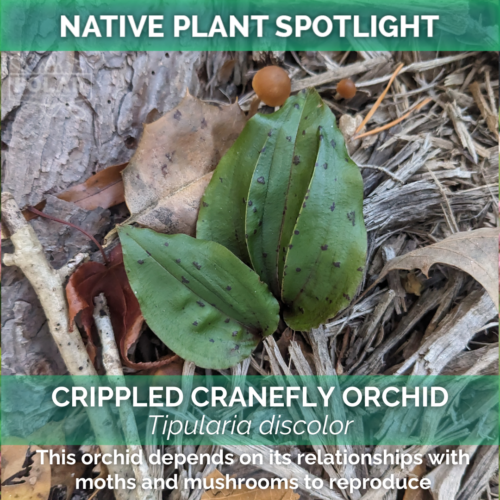
The Crippled Cranefly Orchid is the only orchid in the terrestrial genus Tipularia found in North America. Its family, Orchidaceae, is over 100 million years old! Because its seeds are so tiny, almost dust-like, they rely on the support of existing mycorrhizal fungi systems making nutrients available from rotting wood. Note the mushrooms popping up nearby! The spotted leaves with striking purple undersides pop up in autumn to collect sunlight through the winter when the leaves of trees have fallen. The leaves die back in early spring, replaced by flowers that persist from June to September. The flowers are specially shaped to attach pollen to the eyes - yes, the eyes - of a specific small moth species, who then transfer it off of their eyes to other flowers.

Pink Muhly Grass (Muhlenbergia capillaris) finishes its growing season with a puffy pink cloud of seedheads, making it a popular plant for garden edging and dry, sunny spots. It is the host plant of the Orange Skipperling butterfly (Copaeodes aurantiaca), and it provides habitat for other pollinators, offering shelter and nesting material for wildlife through the winter months.
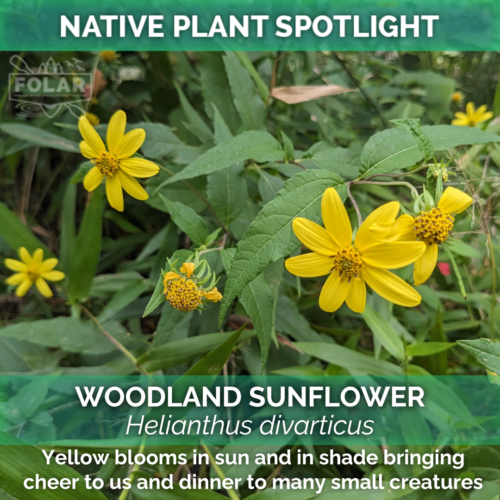
Our native Woodland Sunflower (Helianthus divarticus) and September's Native Plant Spotlight is a frequently-seen bright pop of color along the Appomattox River Trail, even in the shadiest areas. This flower grows to around five feet tall and is a food source for wildlife throughout its growth cycle. It serves as a host plant for beautiful butterflies and moths, its blooms are an important pollen source for our native bees, and its seeds are eaten by songbirds.

Spotted Joe Pye Weed loves a wet soil and full sun, thriving in marshes, waterside, and ditches or dips in the land. It hosts moth species, including the particularly pretty Clymene Moth, Ruby Tiger Moth, and Ironweed Clearwing Moth. In addition to pollinators, Joe Pye Weed is also appreciated by humans for its long-lived dusty rose-colored blooms that last July through the end of August.

July's Native Plant Spotlight is the American White Water Lily! This plant has several common name variations, such as Fragrant White Water Lily, even though this plant’s flower can be pink. Its underwater tuber roots receive oxygen and other gases through spongey channels in the stems of the leaves floating on the surface. Those tubers are also a favorite snack of many of our water mammals, like beavers and muskrats. The flower blooms for about three days a year per plant. We've seen them blooming in early July along the Appomattox River Trail. The blooms close at night and open on bright sunny days, and after they are pollinated, the flowers develop seeds that are eaten by waterfowl.

Trumpet Vine, AKA Trumpet Creeper, is sure to split the room for gardeners. Widely considered an aggressive grower, the vine can scale up to 35 feet in full or part sun. It is an invasive species in some other places around the world, but here in Virginia it is a native species with ecological benefits, such as being the host plant for moth species, and a major food resource for our beloved hummingbirds. Perhaps a great alternative to invasive Wisteria species for pergolas and other garden vine uses.

Yarrow, with its fern-like leaves and flower clusters which act as landing platforms for dining butterflies, is native to many areas around the world- there are many popular cultivars in wide color varieties. Common yarrow (the native variety) spreads readily by seed dispersal and underground “suckering,” which may require maintenance in a garden over the years. Highly recommended for garden & meadow plantings, it is also a host plant for many moths, including the adorable Blackberry Looper moth. In turn, the moth caterpillars provide food for baby birds in the springtime.

The black locust, while not always perfectly behaved as a garden tree, can be an excellent focal point that provides shade and visual interest to spaces. The white hanging flowers are attractive not only to humans, but to native pollinators like bumblebees and butterflies. Birds also eat the buds and seeds of this tree and use the branches as protective habitat. This tree has a habit of sending out new shoots via underground “suckers,” and combined with the thorns found on the young branches, black locust trees require some attention in garden spaces until a single larger trunk is established. This tree is a host plant to several butterfly caterpillars, including the Clouded Sulfur. Highly recommended for soil stabilization or in places where other trees have struggled!

March's Native Plant Spotlight is a springtime powerhouse. Violets bring color to our outdoor spaces, but many more benefits for wildlife. Not only is the nectar of this flower an incredible early resource for our native pollinators, but it is also the host plant for lovely Fritillary butterfly caterpillars, like this one pictured. The plant itself is used as a food resource for wild turkeys, rabbits, several birds, and even humans! Encouraging this flower in our tended spaces can support our natural community.
Image 40598 from Pickpik.com; used with Creative Commons License

February’s Native Plant Spotlight is highlighting the decadent red late-winter berries of our native Swamp Rose. Widely native to eastern North America, this plant loves a bog, tolerating floods but unable to grow in standing water. It will thrive best in full sunlight, spreading by underground “suckers” to form cover for wildlife and fragrant floral displays that feed pollinators from May to July. The berries (or rose hips) are a food resource for songbirds, quail, wild turkeys and small mammals — they are also edible to humans and are known to be high in vitamin C.

Bald cypress is an unusual native tree. Tolerant of dry soils, the tree is happiest in wet or even flooded areas. The roots are capable of surviving these conditions potentially due to growths called cypress knees that grow above the water levels and aerate the roots, as well as keep the tree structure sturdy and upright in soft, muddy ground. Another uncommon feature is that Bald Cypress are conifers (like pine trees) that are deciduous; they drop all of their needles in the fall, re-growing them in the spring.
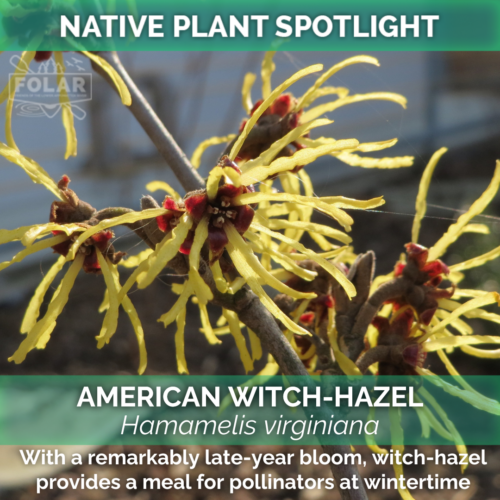
Known as American Witch-Hazel or Common Witch-Hazel, this deciduous shrub or small tree features one of our latest blooms of the year. This plant is known to bloom from September to December and the ribbon-like shape of the petals protect the blooms from the worst of the elements. This small tree will rarely grow taller than 12-15 feet, and displays lovely yellow leaves in the fall before leaf shed, blooming after the branches are bare.

Blunt-Lobed Cliff Fern is a beautiful leafy fern that can survive in very dry shaded places. This specimen was discovered at the Appomattox River Trail during FOLAR’s November Stewardship Saturday. Under freshly-cleared invasive wisteria vines that were climbing the historic stone walls along the river, our native Woodsia obtusa was showing off its ability to grow in the most barren of spaces- a crack between rocks! Celebrated by gardeners for its ability to fill in the dryest nooks in the shade garden, this native plant is also deer and rabbit resistant.

As the season shifts to cooler weather, pollinators are busy collecting the last of their food resources from blooms. Many of the fall blooms they will find are asters. White panicle aster is a flower that can be found in 2 to 5 feet arching mounds in gardens and moist meadows, enjoying full sun and tolerating partial shade. It is easy to grow from seed sown directly into the ground in the fall or early spring. A critical resource for birds too, who can get some pre-winter nutrition from the many pollinators dining on pollen and nectar.
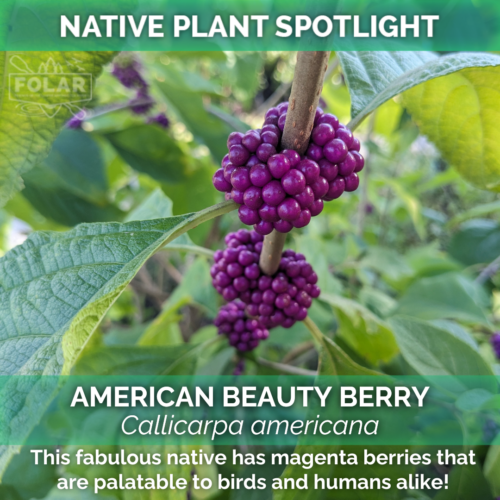
The American Beautyberry, with lime green leaves and bright pink-magenta berries, can be visually distinguished from its East Asian cousin (Callicarpa dichotoma) which has a more subdued blue-green leaf and a cool-toned purple berry. The native Beautyberry is an important food source for over forty species of songbird and several of our four-legged wildlife species. Research has concluded that the crushed leaves of American Beautyberry are a mosquito repellant. The beautyberry is a large shrub that grows like a fountain, with branches arching out from a central point, 5 to 8 feet wide and tall when fully grown. It prefers dappled shade, often found at forest edges. The American variety boasts a sweetness that most other beautyberries do not, which makes it palatable for humans, and a great ingredient for jams!

A Virginia native cactus, with a gorgeous flower and an equally vibrant, edible fruit, the Eastern Prickly Pear prefers full sun and dry conditions. You can see its stunning blooms from June to July, and can harvest the bright red-to-purple fruit from late summer into the winter. Watch out for those spines though - a pair of tongs is recommended to harvest a fruit, though we have also seen folks burning the spines off the fruits with a blowtorch to harvest them! Propagating this plant is as easy as cutting off a leaf-pad from an established plant, and placing it cut-side-down in dry soil or sand.
Flowering photo taken by Elise Neuscheler.
Fruiting photo used under Creative Commons License, Wikimedia Commons, by author Alefirenko Petro.

Liatris spicata, also known as Dense Blazing Star or Dense Gayfeather, is a great upright native flower for gardens. It holds special value for our bumble bees, though butterflies and hummingbirds are also known to visit this flower, with birds returning through the winter for its seeds. A lovely late summer flower, it is highly adaptable to many soil conditions and hosts the larvae of several moth species, including the pink “Glorious Flower Moth,” Schinia gloriosa.

Known by many names such as shadblow, saskatoon, sugarplum, serviceberry, and even chuckley pear, there is at least one Amelanchier species native in each of the contiguous 48 states and into southeastern Canada. The species are able to cross-pollinate one another, leading to many hybrids which are often difficult to distinguish. The bush blooms white in early spring, during shad fishing season, which lend to the "shadblow" and "shadbush" regional common names of the plant. The berry fruit is edible for humans and varies by species in sweetness, and the plant overall is an amazing food resource for wildlife - birds, pollinators, hosted caterpillars, deer, and small mammals use this shrub as a diet resource.

An easy way to tell apart our native Wisteria from the invasive one is the timing of the blooms. The invasive Wisteria blooms in late April, before the vine's leaves are fully out, and our native blooms in early May, after the vine has fully put out its leaves. More aggressive than our native, you will see Wisteria sinensis taking over natural spaces and crowding and choking our native plants. Our native is less damaging for our forest canopy and for decorative uses like growing on buildings and arbors.
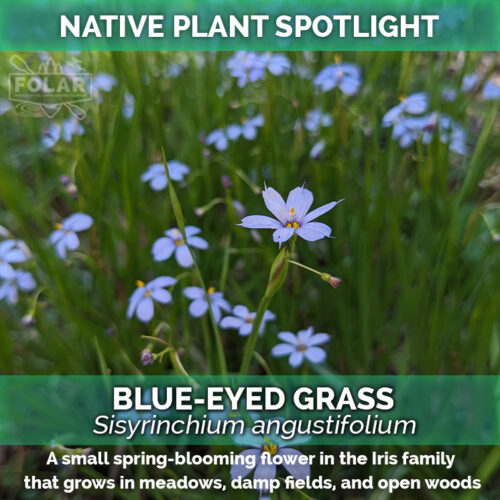
This petite iris (no more than 18 inches tall) is easily found blooming along the Appomattox River Trail during its long spring bloom period - go out and see if you can spot it! When not in bloom, blue-eyed grass can be difficult to identify among the grasses of their preferred habitat. Plants in the iris family feed small insects like aphids, which in turn are a food source for birds and ladybugs. Well-liked by pollinators, this flower is visited by butterflies and bees. The flowers close up at night, and re-open at day. Its small size and controlled spread (multiplies by the rhizome roots and is easy to divide) makes it a great plant for an ornamental garden.

Bloodroot, or Sanguinaria canadensis, is one of these critical early flowers that help insects shake off the winter sleepies and get buzzing. They are named for the bright red sap in the plant, especially from the rhizome roots. Because the seeds from this flower could take up to two years to germinate, the easiest way to propagate them is by dividing the rhizomes in the spring or the fall.
1st photo by Jay Sturner via wikimedia.org. Bee photo taken by Susan Ruggles and made public with Creative Commons 4.0 licensing on Flickr: https://www.flickr.com/photos/ruggless/51867238310

Check out this little-known, edible native plant! Called by many names, including potato bean, Indian potato, cinnamon vine, & perhaps most commonly "groundnut," Apios americana is a perennial vine that bears edible beans and substantial edible tubers. Native varieties of this plant are found across North America. Indigenous peoples of North America used the plant as a food resource, and it is thought to be one of the bean crop options used in Native American "three sisters" plantings which include a squash, a bean, and a corn crop grown together.
Today, the American groundnut is cultivated mostly in Asia. In particular, it is grown for sale in the Aomori Prefecture of Japan, where it has become a culinary specialty.
This picture was taken by our Environmental Stewardship Coordinator, Elise! She grew them in her garden and tried them out - "the taste is slightly sweeter and nuttier than a potato, with a more fibrous texture. Will be growing more!" Second photo by Christina Butler. Third photo by James St. John. Sourced from wikimedia.org.

American Holly (Ilex opaca) is a beloved decorative plant for the winter holidays.
The females of this tree produce a bright red berry that will last through the winter, eaten by overwintering birds. When spring arrives, migrating birds like Cedar Waxwings (Bombycilla cedrorum) will clean out the last of the berries on their way north, and new budding leaves will replace leaves that reach the end of their 2-3 year life span.
Our Partners




























